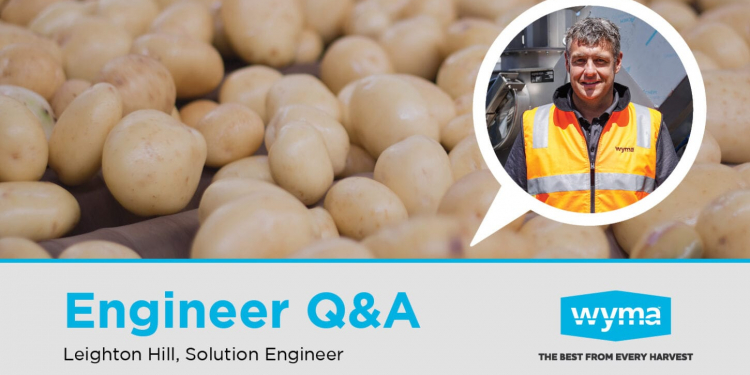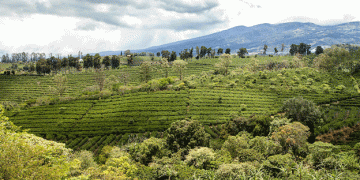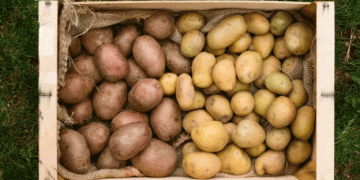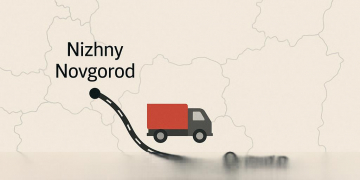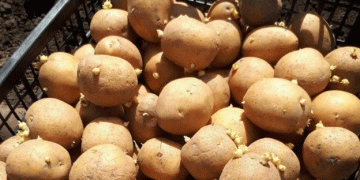Following on from our guide How to reduce the impact of potato bruising on your profitability, we caught up with Leighton Hill, Solution Engineer, to answer some of your questions about gentle handling, why some fertilizers increase the likelihood of bruising and the perfect temperature for potato processing.
Q: Can you discuss more around what a potato bruise is and why they occur?
A: There are four main types of potato bruising: shatter bruises, blackspot bruises, pressure bruises and skinning/feathering. Shatter bruises look like cracks in the skin and appear because tissue separation and periderm damage occur when the potato is harvested and handled when pulp temperatures are too cold. Blackspot bruises occur beneath the skin’s surface and appear in response to a blow which damages internal cells where enzymes and substrates react to reveal a darker area of pulp.
These types of bruises typically occur in warmer temperatures or dry conditions. Pressure bruises also occur beneath the skin’s surface and appear as depressed, dark and sunken areas of pulp. These areas of softened pulp can sink in over time and cause a cavity. Pressure bruises occur due to pressure or weight, usually from other potatoes in low humidity storage1. Potato skin that becomes scuffed or starts rubbing off is known as skinning or feathering. This happens when unripe potatoes are handled roughly and cause the skinned area to become dark if exposed to wind, sun or dry air.

Q: What are the risks associated with potato bruising?
A: There are two major concerns with potato bruising: the first is the cosmetic factor which will result in the end consumer rejecting the produce. The second is the elevated risk of storage born diseases such as Fusarium dry rot, Pythium leak, late blight and early blight. Bruising is a serious problem and is a huge economic drain on the industry, costing the potato industry hundreds of millions of dollars every year. Most of this cost is eventually passed back to the grower with lower prices, reduced demand and increased storage costs.

Q: In a nutshell, how can I prevent potato bruising?
A: A holistic approach to prevention is needed to reduce potato bruising and, ultimately yield losses. The entire process of the potato, right from preparing the soil for planting through to packaging needs to be approached with gentle handling in mind. Each potato process will have unique requirements based on the soil, temperature, humidity, type of produce and end purpose. For specific advice for your conditions, please seek independent advice.
Q: Are there certain types of fertilizers that can increase the likelihood of bruising? And if so, why do they increase this chance?
A: Nitrogen based fertilizers can increase the likelihood of bruising during harvest, so caution should be taken. This is because if under or over used during fertilisation, nitrogen begins to affect the maturity, yield and health of the potatoes. Too little nitrogen can result in premature crop senescence and an increase in blackspot bruising. As the crops are generally smaller in size, there are sufficient yield losses.
Process quality is poor due to high sugar and low dry matter contents. Too much nitrogen can result in crops that are immature, easily bruised and have a higher susceptibility to diseases. Dry matter decreases with increasing nitrogen and sugar levels also increase, resulting in poor process quality. The ideal fertiliser for your produce depends greatly on soil fertility, pH levels, weather, humidity and organic matter. Soil samples should be taken to help determine the correct fertiliser for your produce.
Q: Why should potatoes be handled between 8°C – 10°C? How does this affect the quality of the produce?

A: Handling potatoes between 8°C – 10°C will lessen the risks of bruising, immaturity, spouting and diseases. Respiration consumes oxygen and releases carbon dioxide, volatile gases, water and heat, which increases the risk of bruising, sprouting and immaturity. However, this is kept to a minimum outside of 3°C – 15°C (generally speaking, temperatures may vary for different types of potatoes). Pulp temperature is a major factor in potato bruising, which occurs when a potato impacts another surface. For example, a shatter bruise is likely to appear when a potato with a colder pulp temperature experiences impact.
Q: What are the key parts of post-harvest processing that I should be monitoring for gentle handling?
A: All elements of your potato processing line should be optimised for gentle handling. From the engineering of each individual piece of equipment through to total line design will impact your produce and your profitability. For example, any drop/fall in your line should be no more than 30cm and should include fall impact dampeners, the belt speed should run under 40m per minute and impact protection should be at any impact point. Minimum shaking along the line and minimum aggression from destoners/debris removers are also highly important.
